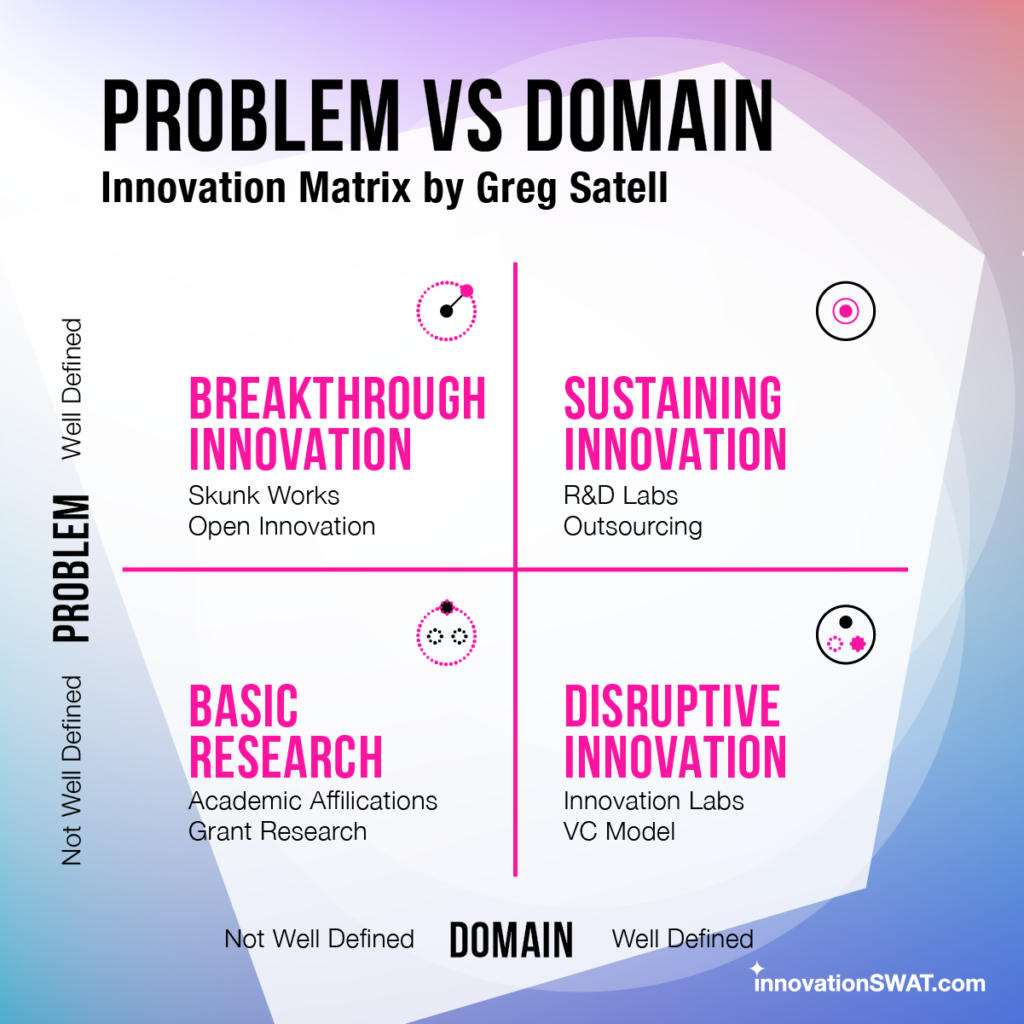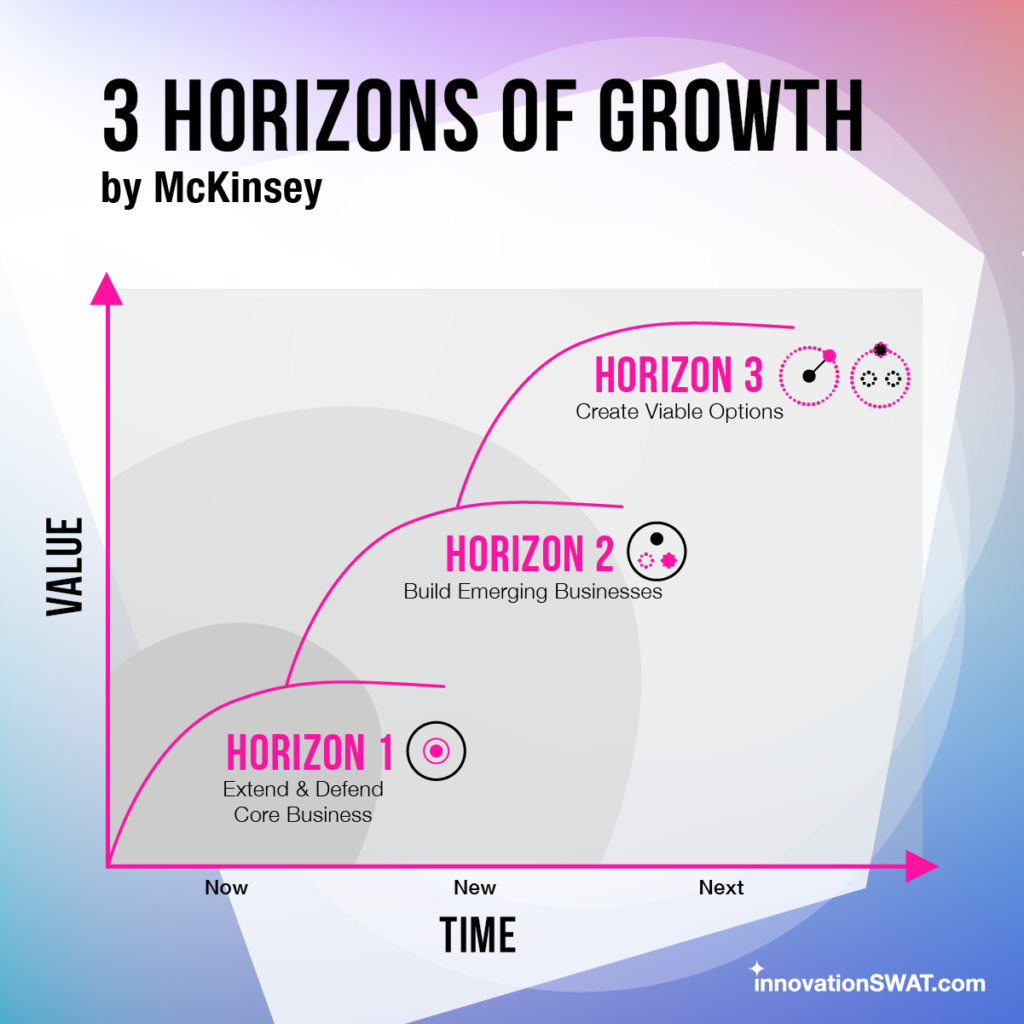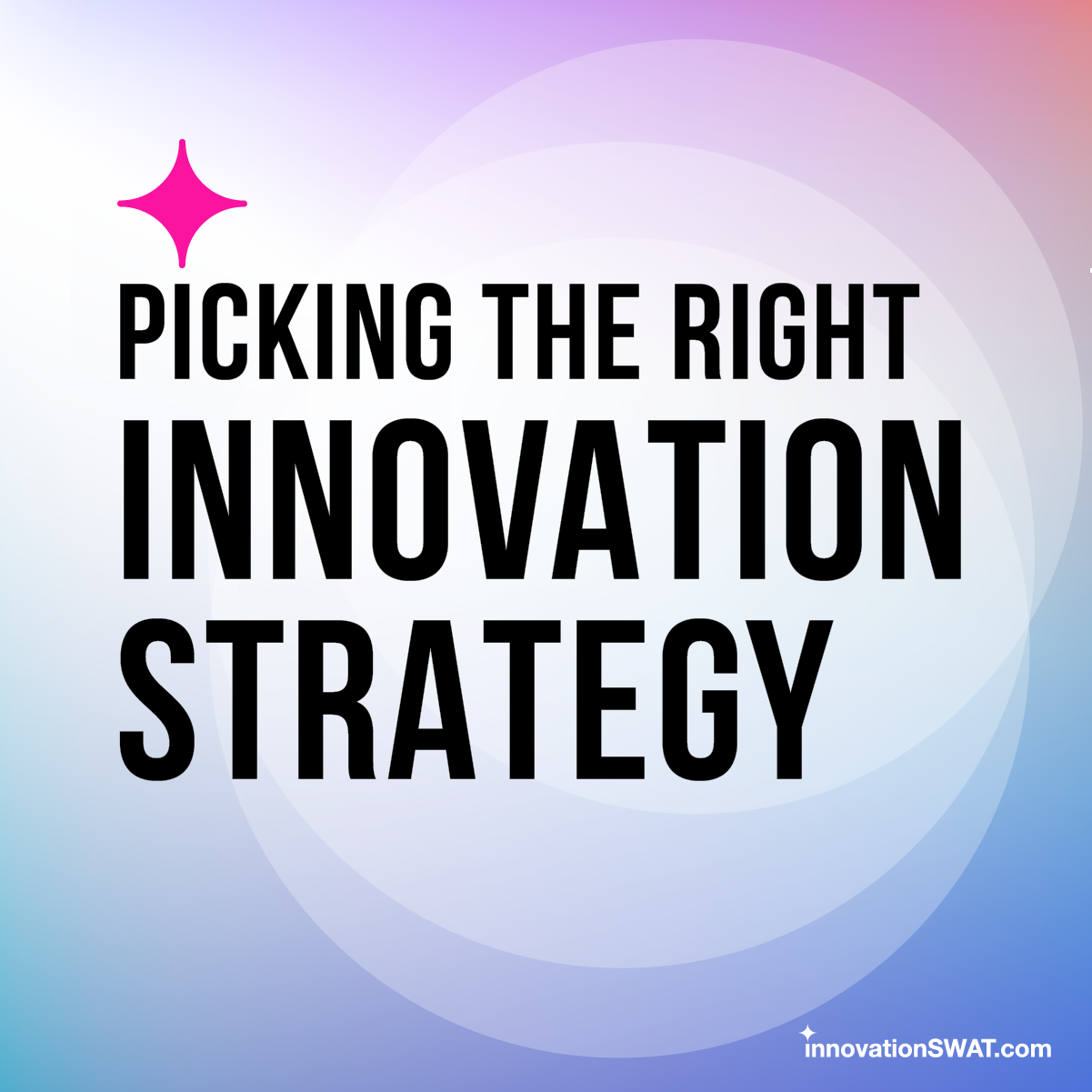There are many methods to map innovation strategy, which one work best for your business? This article introduce some popular innovation models from different perspectives to help guide innovation strategy & operation focus decisions.
Problem vs Domain – Innovation Matrix by Greg Satell

Sustaining Innovation:
This type of innovation focuses on improving existing products, services, or processes within an established market. It aims to enhance performance, efficiency, or user experience without fundamentally changing the core offering. Sustaining innovation helps companies maintain their competitive advantage and keep up with customer expectations.
Disruptive Innovation:
Disruptive innovation introduces a new product or service that initially caters to a niche market or a group of underserved customers. It often offers a simpler, more affordable, or more accessible alternative to existing solutions. Disruptive innovations gradually gain popularity and eventually disrupt established markets, displacing existing products or services.
Breakthrough Innovation:
Breakthrough innovation involves creating revolutionary advancements that significantly transform industries or create entirely new markets. It entails developing groundbreaking technologies, processes, or business models that revolutionise how things are done. Breakthrough innovations often require substantial investment, carry high risks, and have the potential for substantial rewards.
Basic Research:
Basic research, also known as pure or fundamental research, focuses on expanding scientific knowledge and understanding without any immediate practical application in mind. It aims to explore and discover new principles, theories, or phenomena. Although the outcomes of basic research may not have immediate commercial value, they can lay the foundation for future innovations and breakthroughs.
Functional & Operational Based – 10 types of innovation by Doblin – Deloitte

Profit Model:
This type of innovation involves finding new ways to generate revenue and increase profitability. It includes exploring different pricing strategies, revenue streams, cost structures, and business models to enhance financial performance.
Network:
Network innovation focuses on creating or leveraging partnerships, alliances, and collaborations to gain a competitive advantage. It involves developing relationships with suppliers, distributors, customers, or other organisations to improve efficiency, reach new markets, or access additional resources.
Structure:
Structure innovation focuses on organisational design and internal processes. It involves reconfiguring departments, teams, workflows, and decision-making processes to enhance efficiency, agility, and collaboration within the organisation.
Process:
Process innovation aims to improve operational efficiency and effectiveness. It involves rethinking and redesigning existing processes or introducing new ones to streamline operations, reduce costs, increase productivity, and enhance quality.
Product Performance:
Product performance innovation focuses on improving the features, functions, and capabilities of a product or service. It aims to enhance its performance, reliability, durability, ease of use, and other attributes to deliver superior value to customers.
Product System:
Product system innovation involves creating complementary products or services that enhance the overall customer experience or provide additional value. It focuses on developing ecosystems or platforms that integrate multiple products or services to offer a more comprehensive solution.
Service:
Service innovation focuses on improving the customer experience and supporting customers throughout their journey. It involves enhancing customer support, after-sales service, customisation options, convenience, and other service-related aspects to differentiate from competitors.
Channel:
Channel innovation involves finding new ways to deliver products or services to customers. It includes exploring alternative distribution channels, adopting digital platforms, or creating innovative retail experiences to improve accessibility and reach.
Brand:
Brand innovation focuses on developing a compelling brand identity, reputation, and emotional connection with customers. It involves differentiating the brand through storytelling, visual design, marketing strategies, and customer engagement to build loyalty and preference.
Customer Engagement:
Customer engagement innovation aims to deepen the relationship and interaction between the company and its customers. It involves leveraging technology, social media, data analytics, and personalised experiences to create meaningful and ongoing engagement.
Where to Play vs How to Win – The Innovation Ambition Matrix by Bansi Nagji & Geoff Tuff

Core Innovations:
Core innovations focus on making incremental improvements to existing products, services, or processes within the current market context. They involve optimising and enhancing current offerings to maintain competitiveness and meet evolving customer needs. Core innovations aim to improve performance, efficiency, or user experience while leveraging existing capabilities and resources. They are typically feasible, low-risk, and provide steady progress for the organisation.
Adjacent Innovations:
Adjacent innovations involve expanding or adapting existing offerings to enter new markets or serve different customer segments. They leverage the organisation’s existing capabilities, technologies, or know-how and apply them in novel ways. Adjacent innovations aim to provide additional value to customers by addressing related or adjacent opportunities. They require moderate levels of investment and carry somewhat higher risks compared to core innovations. Adjacent innovations can help organisations explore new growth avenues and diversify their offerings.
Transformational Innovations:
Transformational innovations aim to create significant changes within the organisation or industry. They involve fundamental shifts in business models, technologies, or processes, resulting in substantial improvements in performance, customer experience, or value creation. Transformational innovations have the potential to disrupt existing markets, create new markets, or redefine industries. They often require substantial investment, involve higher risks and feasibility challenges due to their disruptive nature. Transformational innovations are strategic initiatives that can drive long-term growth and competitive advantage.
3 Horizons of Growth – Mckinsey

McKinsey’s Three Horizon Framework is a strategic model that helps organisations manage and balance their innovation efforts across different time horizons.:
Horizon 1:
Horizon 1 represents the first time horizon and focuses on the current core business operations. It involves optimising and improving existing products, services, and processes to sustain and enhance performance in the short term. Horizon 1 innovations typically involve incremental improvements, cost reduction initiatives, and efficiency gains. The goal is to maintain competitiveness, meet customer needs, and generate reliable cash flow from existing operations.
Horizon 2:
Horizon 2 represents the second time horizon and focuses on emerging opportunities for growth and expansion. It involves developing new products, services, or business models that leverage existing capabilities to capture new market segments or serve adjacent customer needs. Horizon 2 innovations aim to generate additional revenue streams and explore new avenues for business growth. These initiatives may involve moderate levels of risk and investment but have the potential to drive future profitability and market share.
Horizon 3:
Horizon 3 represents the third time horizon and focuses on creating disruptive innovations and exploring entirely new markets or industries. It involves pursuing radical or breakthrough innovations that have the potential to disrupt existing business models, technologies, or markets. Horizon 3 innovations often involve high levels of uncertainty, experimentation, and long-term investment. The goal is to identify and develop new growth platforms that can drive future competitiveness and shape the organisations future.
Front & Back End Innovation vs Silo Functional innovation
It is easier to focus to improve one’s functional improvement, the difference in functional KPI creates silos and possible conflicting interests. Which could actually pull the organisation apart without synergy and integrated vision.
Front-end & Back-end should have a common goal with customer-centric mindset, create differentiated customers value yet optimise cost to maximise profitability
Front-end innovation to improve top-line, customer’s willingness to pay, customer loyalty, WOM, and explore new business opportunities
- Creating new products or services
- Developing new processes or technologies
- Creating new markets or industries
- Entering new markets or industries
- Expanding market share
- Improving customer experience or satisfaction
Back-end innovation to improve bottom-line, operation efficiency, cost reduction, employee satisfaction, employer loyalty
- Increasing operation efficiency with technology
- Improve productivity & yield engineering
- Reducing supply chain or operation costs
- Improving decision speed and quality
What Next?
These models represent different perspectives to guide strategic choices & operational focus.
Depending on business stage & its competitive positioning, innovation leaders required to apply right strategy at the right time.
Then you will need the right team with right capabilities to deliver short & long term goals with execution excellence!
Keep an eye on more articles on how to build the innovation SWAT capabilities & tools to make innovation beyond the strategy.
Download a copy of the iSWAT Booklet – Picking the right Innovation Strategy HERE.


